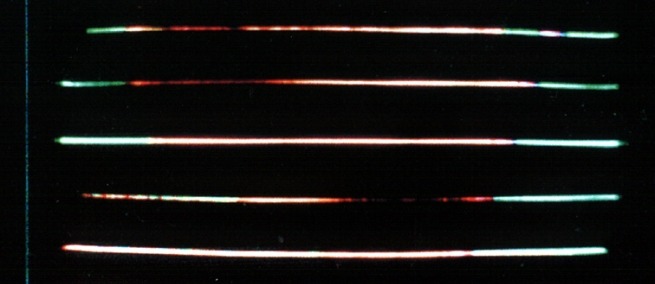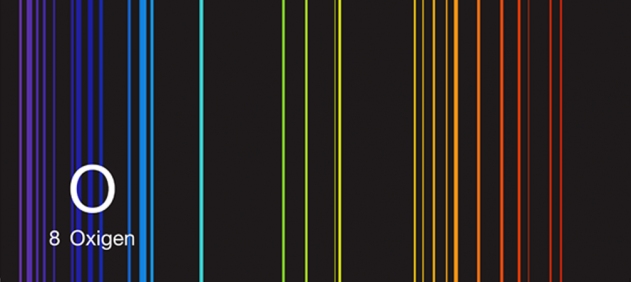
For the past 50 years, pioneering video and installation artist Eugènia Balcells has addressed ways of seeing with her work. Balcells is among such artists as Nam June Paik, Joan Jonas, Gary Hill, Beryl Korot, Frank Gillette, and Martha Rosler who were the first to make multi-screen installations (in the 1970s and ’80s). Balcells' video installation Frequencies (2009) has been on view in Greenpoint, Brooklyn during November and December of 2017 in the space where she lived and worked with the musician Peter Van Riper until his passing in 1998. Balcells now splits her time between New York and Barcelona, Spain where she was born.
In Frequencies, a rainbow vertical color bands sourced from the spectrum of light that each element on the periodic table reflects when light passes through emanates from a wall. “I think that ultimately everything is a frequency,” Balcells told Science & Film when they spoke at the Museum of the Moving Image. “Me, you, this table. Everything is made out of atoms, and the atoms are made out of subatomic particles–electrons, protons, and neutrons. What is there? Vibrations.” Atoms vibrate at different frequencies, especially when light–photons–pass through. The resulting frequency can be interpreted as a color.
To make Frequencies Balcellas collaborated with Santiago Alvarez, a chemist at the University of Barcelona, to ensure the scientific accuracy of her work. Curated by Eulàlia Bosh, who began the education program at the Museum of Contemporary Art of Barcelona, the installation of Frequencies in Brooklyn is accompanied by Balcells’ two-dimensional wall installation Homage to the Elements. One hundred and eighteen squares arranged in the format of the periodic table each display an element’s color as an identifier along with the name and atomic number.

In Balcells’ 1985 work TV Weave, she again distills matter into light. In this piece, rather than extracting light from elements, she abstracts images into light. The work can be installed on anywhere from four to 70 screens, each of which is tuned to a broadcast television channel. “I was already working in video so I was relating to the screen constantly,” Balcells told Science & Film. In 1985, televisions were not digital projections but analogue, backlit by a cathode ray tube which has two oppositely charged poles–negatively charged electrons emitted from one side repel to the opposite where they scan across the glass surface of the tube to create a visible image. Balcells saw “a weaving of electrons,” and she had been working with weavers in North Carolina at that same time. “I thought, what if instead of adding I subtract? That is something I have done very often. There is a complicated way to subtract–to work with a scientist and program a TV screen in such a way that you only have a few lines working, but that is super expensive. So I got black tape. Thick, good, black tape. I put it at one-millimeter distance one from the other [so that] I got practically one line of electrons. Because the two tape edges were so close, and we could control the brightness and saturation of the image, we put it a little onto the strong side.” The brightness of the light shone over the edges of the black tape, Balcells described. “It literally created beats of light in certain moments. When the credits would roll… Amazing, a line of credits!” In both TV Weave and Frequencies, Eugènia Balcells uses light to challenge the subject’s typical presentation.
In 1985 when Balcells made TV Weave, other artists too were using broadcast television programming as a medium. The organization Experiments in Art and Technology, founded in 1966 by artist Robert Rauschenberg and engineer Billy Klüver to pair artists with engineers to create new work, had a project called “Artists and Television.” As Klüver wrote in his March 22, 1971 proposal to the National Endowment for the Arts, “the value of the artist is to expand the esthetic range of broadcast television, to enrich the medium itself and to explore other functions television may have in society.” Video artist Beryl Korot helped found the journal Radical Software in 1970 as a response to new technologies such as Sony’s Portapack which made video more widely accessible, and thus created new possibilities for distribution of information.
Balcells’ work has been exhibited in solo shows at the Barcelona Museum of Contemporary Art, El Museo del Barrio, the Reina Sofia, among other places. In 2009, she was awarded the Gold Medal for Fine Arts and the National Visual Arts Award of Catalonia. The mural Homage to the Elements is permanently installed in the atrium of the Physics and Chemistry Library in Barcelona.
TOPICS